Introduction
Selenium has become the backbone of modern web application testing, offering tools to automate repetitive and time-consuming testing tasks. While Selenium WebDriver and Grid provide powerful solutions for advanced automation testing, the Selenium IDE offers an approachable way for beginners to dive into the world of test automation. In this blog post, we will explore the Selenium IDE basics, its features, advantages, and how you can get started with selenium for automation testing.
The Selenium IDE (Integrated Development Environment) is a browser extension designed to simplify and accelerate the process of writing automated tests. Initially released as a Firefox add-on, Selenium IDE now supports both Firefox and Chrome, making it widely accessible to users of these popular browsers. Unlike Selenium WebDriver, which requires knowledge of programming languages like Java, Python, or C#, Selenium IDE offers a no-code solution, making it suitable for testers, developers, and even those without a coding background.
If you’re interested in learning Selenium testing, Selenium IDE can be a perfect starting point. By taking selenium online courses, you can quickly get up to speed with the basics and enhance your skills further.
Selenium IDE
The Selenium IDE allows users to record their interactions with a web application and automatically generate scripts in various programming languages. This can significantly speed up the test creation process, enabling even non-technical testers to automate tasks without writing a single line of code.
Selenium IDE offers several features that make it an excellent tool for automating web testing, even for beginners:
Record and Playback
One of the most appealing features of Selenium IDE is its record and playback functionality. With this feature, you can simply interact with the web application as you normally would, and the IDE will automatically generate corresponding commands. These commands can then be played back to replicate your actions. This is particularly useful for quick validation tests and simple repetitive tasks.
Command and Scripting Support
Selenium IDE uses a set of commands to perform actions such as clicking a button, entering text in a form, or verifying that an element is present on the page. You can also extend the functionality with custom scripts to include complex logic. Though it is primarily a tool for beginners, it offers enough flexibility for more advanced users to perform detailed and customized tests.
IDE UI and Usability
The Selenium IDE has a clean and user-friendly interface that allows for easy navigation. With its intuitive layout, it’s simple to create and run test scripts, even without prior experience. The user interface provides tools to interact with the recorded tests, edit scripts, and view execution results. This level of simplicity makes Selenium IDE a great tool for anyone getting started with selenium for automation testing.
Supports Multiple Programming Languages
While Selenium IDE is primarily designed for ease of use, it can also export recorded tests in multiple programming languages, including Java, Python, Ruby, and JavaScript. This gives users the flexibility to further edit and integrate the tests into larger automation frameworks. Exporting tests to languages such as Java allows for easy integration with Selenium WebDriver and other tools in the Selenium suite, providing a scalable solution for more complex projects.
Browser Support
The Selenium IDE supports both Firefox and Chrome browsers. Since these are the two most popular browsers, this gives Selenium IDE wide applicability. Users can easily switch between the two browsers based on their testing needs. Although support for other browsers is limited, this dual-browser support ensures that the majority of web applications can be tested effectively.
Data-Driven Testing
Data-driven testing is another key feature of Selenium IDE. It allows you to create tests that can run with different sets of data. By storing the input data in an external file (such as an Excel sheet or CSV file), you can execute the same test with different values, ensuring broader test coverage. This is especially useful when you need to validate an application with different user inputs or conditions.
Selenium IDE Features
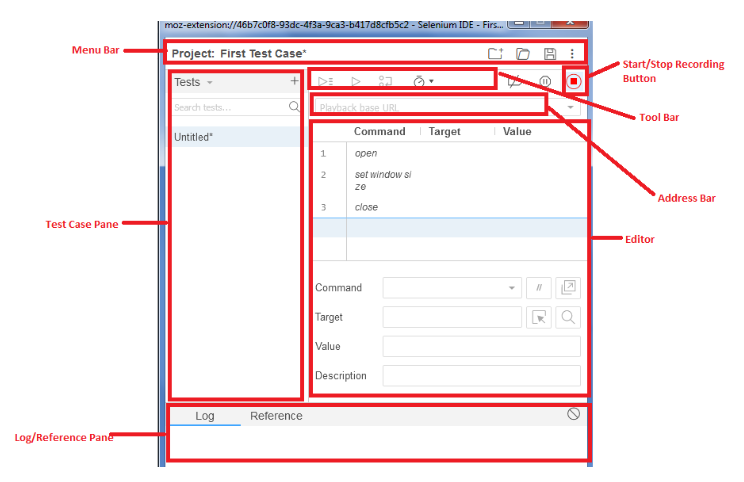
Menu Bar:
Located at the topmost portion contains commonly used commands like Open, Save, Create.

- Project Name is the name given to the project while creating. It can also be renamed.
- Create project is used to create a new project.
- Open Project is used to open any existing project that is saved in your system.
- Save project is used to save the project on the system after it is being created.
Tool Bar:
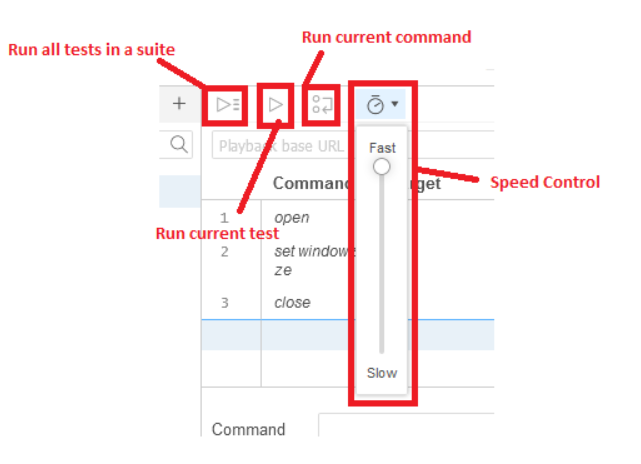
- Speed Control is used to control the speed of Test Script Execution.
- Run all tests in a suite will play all the Test cases listed in the Test Case Pane in sequential order.
- Run current test will play only the currently selected test case.
- Run current command will execute one command at a time and is used for debugging purposes.
Address Bar:
- It contains a dropdown menu which remembers all the previous values.
- The Selenese command open will navigate to the URL mentioned in the Address Bar.
- We will use http://newtours.demoaut.com as a Base URL in this tutorial as this site contains all the elements needed for further topics.
Test Case Pane:
- Selenium IDE will enable you to open more than one test case at a time, and thus the test case pane lists all the currently opened test cases.
- The summary of the number of test cases that were run and failed is available at the bottom portion.
- We can easily navigate between test case and test suite from here.
Editor:
An editor is a place where all the action happens.
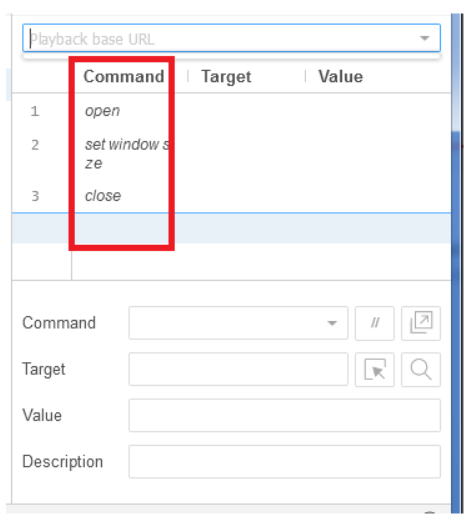
- For creating steps, first, you need to type the name of the command in the Command text box.
- It will automatically start displaying a dropdown list of commands which match the text that you are currently typing.
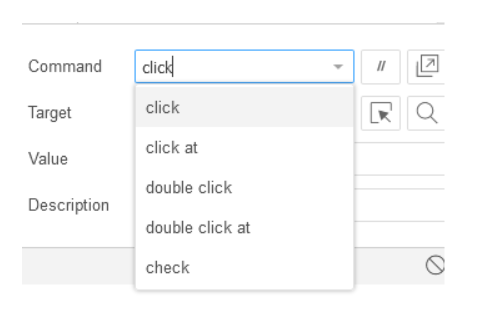
- Target is like a parameter we want to pass (like username, password), and Value is the input value (like ABC, 123) for those Targets.
Log Pane:
The Log Pane displays the runtime messages occurring during the execution of a test case and provides real-time updates about what Selenium IDE is currently doing.
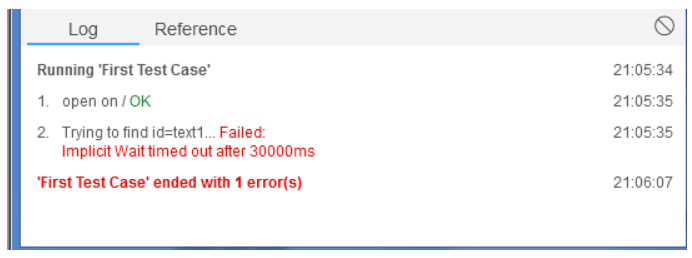
Logs can be categorized into four types:
- Debug: Debug messages are not displayed by default in the log panel and can only be seen when you filter them. It provides technical information about what Selenium IDE is doing in the background. It may display some messages like a specific module has done loading, a particular function is called, or an external JavaScript file is being loaded as an extension.
- Info: It shows the currently executing command.
- Warn: It contains all the warning messages that come across in particular conditions.
- Error: The error messages generated when Selenium IDE fails to execute any command, or a specific condition specified by “verify” or “assert” commands does not fulfill.
Reference Pane:
The Reference Pane shows a brief description of the currently selected Selenese command, description of the locator, and value used in that command.
Disable Breakpoints, Pause Execution and Start/Stop recording
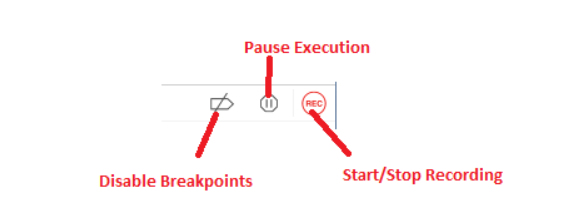
- Disable Breakpoints: It will disable all those steps which are having the breakpoints set for debugging.
- Pause Execution: We can use this option to pause execution if there is any exception in the test case.
- Start/Stop Recording: This is used to stop and start recording the execution happening on a web application.
Outline
- Selenium IDE (Integrated Development Environment) is the most straightforward tool in the Selenium Suite and can only be used as a prototyping tool.
- For intermediate topics such as “runScript” and “rollup” commands, knowledge of JavaScript and HTML is needed. A rollup is a reusable command that can shorten your test scripts. Locators are used to tell Selenium IDE on which element it should operate.
- Firebug (or any similar add-on) is used for obtaining locator values.
- The menu bar is used to create, open, and save test cases into formats that can be used by Selenium RC and WebDriver.
- HTML is the only default format for Selenese commands.
- The Base URL helps in retrieving the relative URL.
- The Test Case Pane displays the list of all currently opened test cases and a summary of test runs.
- The Editor acts as an interface for your test scripts.
- The Log and Reference tab provides feedback and other helpful information while executing tests.
Advantages of Using Selenium IDE
No Coding Required
For those who don’t have a background in programming, Selenium IDE offers a major advantage. It provides a no-code solution for automation testing, allowing you to create tests through simple interactions with the browser. This makes Selenium IDE an excellent choice for testers who are new to automation and want a quick and easy way to get started.
Quick Prototyping
Selenium IDE allows you to quickly prototype your tests. If you’re working on a web application and want to test a new feature, you can record your interactions with the page and replay them instantly to see how the feature behaves. This rapid prototyping feature is a valuable time-saver, especially when you need quick feedback from your automated tests.
Easy Test Maintenance
With Selenium IDE, maintaining test scripts is straightforward. Since the tests are recorded in real-time, making changes to the test scripts is easier. You can modify individual commands or add new ones with just a few clicks. Additionally, the tool allows for easy debugging and error tracking, ensuring that any issues in the tests are quickly identified and resolved.
Free and Open Source
Like the other tools in the Selenium suite, Selenium IDE is free and open-source. You don’t need to worry about expensive licenses or subscription fees, making it an affordable solution for teams of all sizes. The open-source nature also means that the tool is continuously evolving, with regular updates and bug fixes from the developer community.
Conclusion
The Selenium IDE is a fantastic tool for beginners who want to get started with selenium for automation testing. With its user-friendly interface, no-code test creation, and powerful features like recording, playback, and data-driven testing, Selenium IDE provides an easy entry point into the world of test automation.
For those looking to take their skills to the next level, enrolling in Selenium certification courses can help you master advanced Selenium techniques and integrate Selenium IDE with Selenium WebDriver for more complex testing needs.
Ready to start your journey with Selenium? Enroll in H2K Infosys’ Selenium Online Courses today and gain hands-on experience in automation testing.




















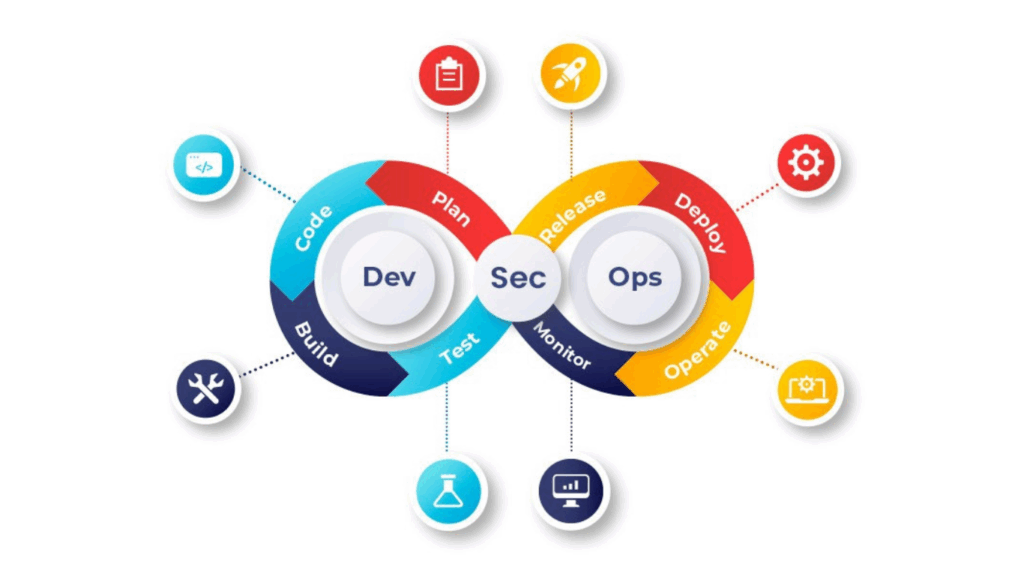









6 Responses